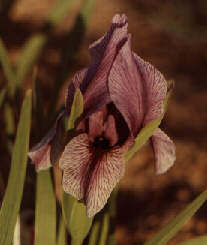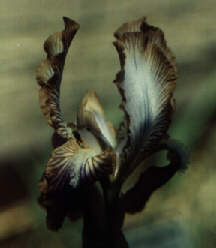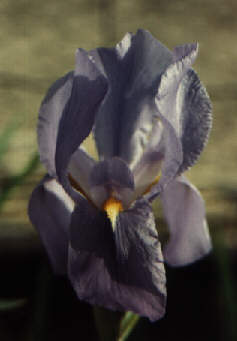History of the Regelia Species
|
Only three of the eight currently-accepted regelia species have contributed to the modern aril and arilbred gene pool. A very brief overview - in the order in which these species were collected, described, and accorded species status: |
|
|
I. korolkowii (Regel, 1873) The best known and undoubtedly most popular of all of the regelia species. The ground color ranges from white through cream to purplish, usually covered with delicate veining of maroon to brown and a small arrow-shaped signal. Range from south-central Asia to northeastern Afghanistan. Many variants have been identified. This is the sole regelia species used in the development of the diploid regeliocyclus. It has entered the gene pool of both diploid and tetraploid arils, and become a significant contributor to the gene pool of today's arilbreds. More history & photos. |
|
|
I. stolonifera (Maxim, 1880) An extremely vigorous species, which spreads by stolons so under favorable conditions it can travel further and faster than the most aggressive TB. The flowers are highly variable with ground colors ranging from white through cream and yellow to blue. Some variants are brownish at the edges, blending to blue in the center. Some are intricately veined. This is a tetraploid species that has contributed significantly to both the aril and arilbred gene pools. Many distinct variants have been noted and a number of selected clones have been registered. More history & photos. |
|
| I. darwasica (Regel, 1884) One of the earliest regelias to be described and cataloged, but now relatively obscure. Lilac ground veined purple, with purple beard. Only two offspring of I. darwasica have been introduced: Van Tubergen's HESPERIA, and McKusick's ANGHARAD. Ironically, an unintroduced sib of ANGHARAD has attained wider distribution but to date none of the descendants of I. darwasica have contributed to the arilbred gene pool. |
Photo Not Available
|
| I. lineata (Foster, 1887) Flowers have a greenish-yellow ground veined brown-to-purple, with bluish beards. So closely allied to I. darwasica that some, including Mathew, have suggested that they are actually variants of one species. Native to Tadjikistan and northeastern Afghanistan. It has not contributed to the gene pool from which registered arils and arilbreds have been produced. |
Photo Not Available |
|
I. hoogiana (Hoog, 1900) One of the more robust regelias, growing from 16" to 32". Its flowers are clear colored, ranging from white through shades of blue to a deep blue-violet, with rarely a trace of veining and never a signal. The flower shown here is a fairly typical, unnamed clone, but a number of selected ones have been introduced. Originally collected in Turkestan, now known to be native to the mountains of southwestern Asia. This tetraploid has contributed significantly to our modern aril gene pool and has now entered the arilbred gene pool as well. The luster of its flowers is a valued trait and its open, but moderate, growth habits lend gardenability to the group. Its clear pattern is a hybridizer's dream, recessive to the more intricate ones of other species. More history & photos. |
|
| I. afghanica (Wendelbo, 1972) A relatively recent discovery, native to the mountains of north-eastern Afghanistan. Described as a bicolor, having pale yellow standards and cream or white ground falls with purple/brown veining, a dark beard and a purple signal patch. Although Mathew (1989) reports it as being in cultivation, it has not contributed to the gene pool from which registered arils and arilbreds have been produced. |
Photo Not Available |
| I. kuschkensis (Grey-Wilson & Mathew, 1973) Purple to purplish-bronze flowers with pale blue beards. Native to the hills of northwestern Afghanistan. It has not contributed to the gene pool from which registered arils and arilbreds have been produced. | Photo Not Available |
| I. heweri (Grey-Wilson & Mathew, 1974) A dwarf Regelia, typically only 4" to 6" tall, with flowers of a uniform mid-to-deep purple. Native to the mountains of northeastern Afghanistan. It has not contributed to the gene pool from which registered arils and arilbreds have been produced. | Photo Not Available |
|
Many reference books provide additional information concerning these species. See the Species List for modern equivalents of other previously-used names that are now synonyms. Of these, Ii.hoogiana, korolkowii, and stolonifera are often included in seed lists and the Aril Society Plant Sale. The others are virtually unobtainable. |
|
History | Hybridizing | Library | List of Cultivars | Photo Gallery


